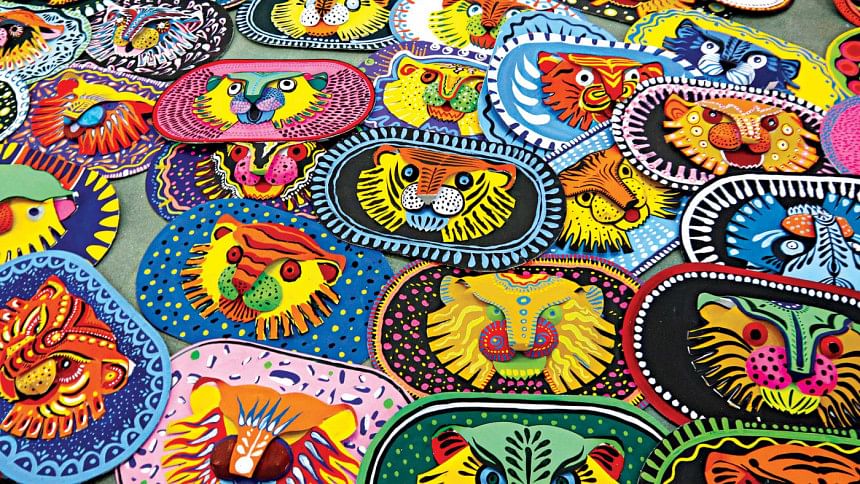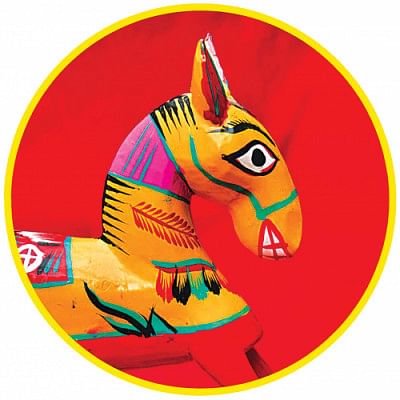The Calendar at the Heart of Bengali Culture

At different times of the year, we often notice our cities and towns adorned in vibrant colours. They are painted yellow on the first day of Falgun. Baishakh is welcomed with fairs and rallies, red and white ensembles, traditional meals, and old customs. Kites fly in the skies of Old Dhaka at the end of Poush, turning it into a kaleidoscope of brightly coloured papers.
This fondness for festivities is summed up in the saying "Bengalis have thirteen parvans (festivals) in twelve months." They observe these age-old cultural festivals by following the Bangla calendar.
There are different schools of thought about how the Bangla calendar has evolved to its present structure. Some contribute it to Mughals and some to Raja Shashank. Regardless of the origin, it was in use during both of these periods. The predecessor of today's Bangla calendar was used to collect taxes in the Mughal era.
The calendar was amended by Dr Muhammad Shahidullah in 1956. Later, the Bangladesh government adopted it as the official calendar in 1986. It has been followed along with the Gregorian calendar ever since. The latest amendment took place in 2019, pushing the first day of spring to February 14.
The cultural celebrations of Bangladesh mostly revolve around its seasons. Pahela Baishakh, the biggest festival of Bengalis, is celebrated to welcome the Bangla New Year. The tradition of opening a new haal khata or a ledger on this day is hundreds of years old.
Barsha utsab is observed to mark the beginning of the monsoon. Sakrain, the kite festival is held at the end of the Bangla month of Chaitra. Boshonto boron, the arrival of spring is rooted in the change of seasons as well.
Some similar festivities are Nabanna, the celebration of the harvest of new crops, boat race, and the pitha utsab which celebrates locally made cakes and desserts. Some of these were previously only held in villages on a much smaller scale. Over the years, connectivity has spread due to the easy access to technology. These festivals have become nationwide celebrations as a result.
Bangladesh's many indigenous communities have multitudes of yearly festivals and traditions, too.The Chakma's Phool Biju, the Tripura's Boisu and the Marma's Sangrai are some of these festivities that take place on the last two days of Chaitra and the first day of Baishakh.
Cultural festivities also include celebrating the lives and works of authors, poets, and philosophers. Rabindranath Tagore's birthday on Baishakh 25 and Kazi Nazrul Islam's birthday on Joishtho 11 are often celebrated together as Rabindra - Nazrul Jayanti, in May. Their contribution to Bangla literature has a great impact on this continent's culture.
Tagore and Nazrul both were influenced by Lalon Shah, one of the greatest minds to ever grace Bengal. His philosophy, poetry, and mysticism have shaped a large part of Bangladesh and West Bengal's spiritual culture.
His search for spirituality denounced caste and creed, the hierarchy of society and the conflict of religious beliefs. Common people could effortlessly access his work because of the simplicity of his language and musical instruments. Lalon criticised the divide in humans while vouching for the search for soul above all else. Thus, he has collected disciples from a wide array of communities.
Lalon passed away on the first day of Kartik of the Bangla year 1297 (1890 AD). Each year on Dol Purnima, fairs are held by his devoted disciples in honour of his work and legacy. The importance of Lalon festivals lies in the fact that they are celebrated by people of all faiths.
Different religious groups abide by their own calendars. The Muslim festivals are celebrated in accordance with the lunar Hijri calendar. Eid-ul-Fitr and Eid-ul-Azha are two of the most prominent yearly occasions for Muslims. The Bangla calendar is thought to be influenced by this calendar by a group of historians.
Hindu religious festivals follow their own Panjika. It has a difference of one day from the official Bangla calendar. Some historians believe that the ancient Hindu traditions that circled around the sun, called Surya in Sankrit, have much influence on today's Bangla calendar. Durga Puja is the main annual Hindu festival. Their other celebrations include Holi, Kali Puja, Saraswati Puja, and many more.
Buddhists follow a lunisolar calendar, which follows the orbits of both the sun and the moon. Although, it is largely based on the calendar used by the Hindus. Buddhists in Bangladesh celebrate Buddha Purnima, Madhu Purnima and Kathin Chibar Dan.

National holidays that stem from political events such as the International Mother Language Day, Independence Day, and Victory Day refer to the Gregorian calendar. The Bangla calendar was amended to match the Gregorian calendar for this specific reason, proving that since its birth, Bangladesh has favoured the English calendar for official purposes.
There is little to no practical use of the Bangla calendar in academia or offices. Schools, colleges, and universities exclusively use the Gregorian calendar on daily basis. Non-government institutions are pretty much the same. Some government documents still have the Bangla dates written along with the English ones. But even then, the English calendar is prioritised.
The Bangla months and dates are still written by some institutions and media. Newspapers and television channels feature news regarding Bangla months and seasons. People involved with art, culture, and literature keep the calendar close to their hearts.
University students play a large part in keeping the traditions alive by planning yearly festivities such as Mongol Shobhajatra and painting alpona. Local brands and institutions arrange seasonal fairs and exhibitions. But these celebrations have inevitably been influenced by globalisation.
In recent years, local festivals have been incorporating more and more foreign elements. Sakrain, the kite festival, has gone through significant changes over the years. The main focus has shifted from flying kites to fireworks and music. The timeline has also been shortened from a month-long homely arrangement to one single day.
Along with the evolution of local traditions, people now celebrate and observe international days with increasing fervour. The New Year on January 1, Valentine's Day (which coincides now with Pahela Falgun), and International Women's Day are just to name a few.
The Bangla calendar is rooted deeply in Bangladeshi hearts and culture even though the offices and academics depend heavily on the Gregorian calendar. Most of the country's traditional, cultural, and indigenous festivals rely on the Bangla dates. These rituals, utsabs and parvans are old as the Bengal is. Passed down from generation to generation, they tie Bengalis past and present together and weave the tapestry of their collective identity.
Shimin reads everything she can find, talks to cats, and writes a lot of letters. Send her a book at [email protected]

 For all latest news, follow The Daily Star's Google News channel.
For all latest news, follow The Daily Star's Google News channel. 



Comments